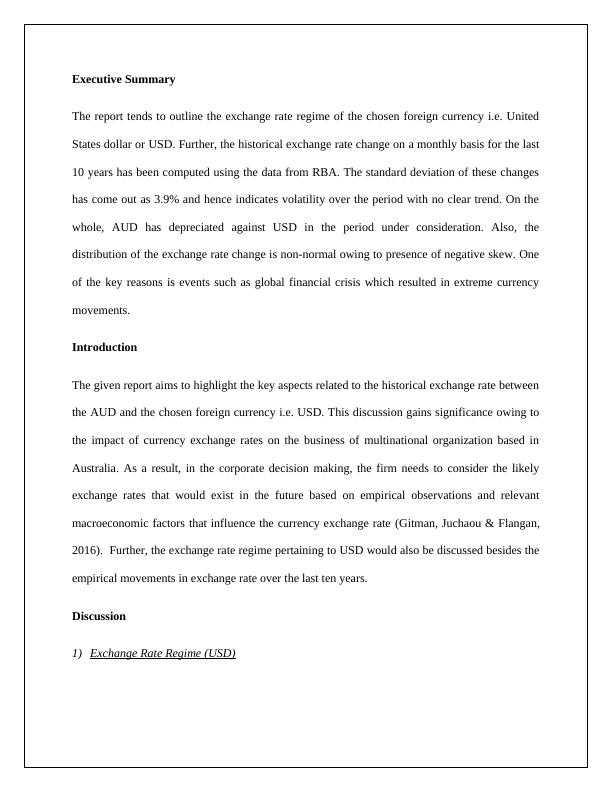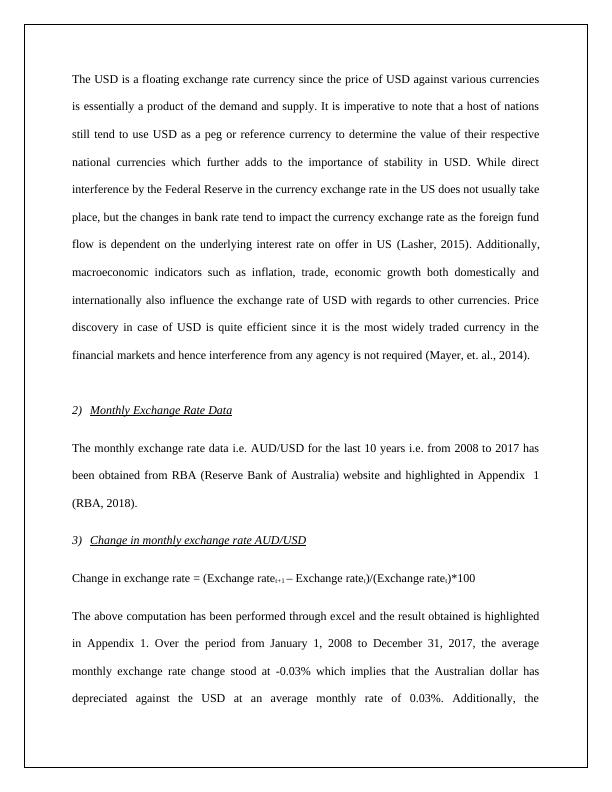Exchange Rate Regime and Historical Exchange Rate Analysis of AUD/USD
Added on 2023-06-10
9 Pages1443 Words298 Views
International Financial
Management
Assignment
Student Name/Id
[Pick the date]
Management
Assignment
Student Name/Id
[Pick the date]

Executive Summary
The report tends to outline the exchange rate regime of the chosen foreign currency i.e. United
States dollar or USD. Further, the historical exchange rate change on a monthly basis for the last
10 years has been computed using the data from RBA. The standard deviation of these changes
has come out as 3.9% and hence indicates volatility over the period with no clear trend. On the
whole, AUD has depreciated against USD in the period under consideration. Also, the
distribution of the exchange rate change is non-normal owing to presence of negative skew. One
of the key reasons is events such as global financial crisis which resulted in extreme currency
movements.
Introduction
The given report aims to highlight the key aspects related to the historical exchange rate between
the AUD and the chosen foreign currency i.e. USD. This discussion gains significance owing to
the impact of currency exchange rates on the business of multinational organization based in
Australia. As a result, in the corporate decision making, the firm needs to consider the likely
exchange rates that would exist in the future based on empirical observations and relevant
macroeconomic factors that influence the currency exchange rate (Gitman, Juchaou & Flangan,
2016). Further, the exchange rate regime pertaining to USD would also be discussed besides the
empirical movements in exchange rate over the last ten years.
Discussion
1) Exchange Rate Regime (USD)
The report tends to outline the exchange rate regime of the chosen foreign currency i.e. United
States dollar or USD. Further, the historical exchange rate change on a monthly basis for the last
10 years has been computed using the data from RBA. The standard deviation of these changes
has come out as 3.9% and hence indicates volatility over the period with no clear trend. On the
whole, AUD has depreciated against USD in the period under consideration. Also, the
distribution of the exchange rate change is non-normal owing to presence of negative skew. One
of the key reasons is events such as global financial crisis which resulted in extreme currency
movements.
Introduction
The given report aims to highlight the key aspects related to the historical exchange rate between
the AUD and the chosen foreign currency i.e. USD. This discussion gains significance owing to
the impact of currency exchange rates on the business of multinational organization based in
Australia. As a result, in the corporate decision making, the firm needs to consider the likely
exchange rates that would exist in the future based on empirical observations and relevant
macroeconomic factors that influence the currency exchange rate (Gitman, Juchaou & Flangan,
2016). Further, the exchange rate regime pertaining to USD would also be discussed besides the
empirical movements in exchange rate over the last ten years.
Discussion
1) Exchange Rate Regime (USD)

The USD is a floating exchange rate currency since the price of USD against various currencies
is essentially a product of the demand and supply. It is imperative to note that a host of nations
still tend to use USD as a peg or reference currency to determine the value of their respective
national currencies which further adds to the importance of stability in USD. While direct
interference by the Federal Reserve in the currency exchange rate in the US does not usually take
place, but the changes in bank rate tend to impact the currency exchange rate as the foreign fund
flow is dependent on the underlying interest rate on offer in US (Lasher, 2015). Additionally,
macroeconomic indicators such as inflation, trade, economic growth both domestically and
internationally also influence the exchange rate of USD with regards to other currencies. Price
discovery in case of USD is quite efficient since it is the most widely traded currency in the
financial markets and hence interference from any agency is not required (Mayer, et. al., 2014).
2) Monthly Exchange Rate Data
The monthly exchange rate data i.e. AUD/USD for the last 10 years i.e. from 2008 to 2017 has
been obtained from RBA (Reserve Bank of Australia) website and highlighted in Appendix 1
(RBA, 2018).
3) Change in monthly exchange rate AUD/USD
Change in exchange rate = (Exchange ratet+1 – Exchange ratet)/(Exchange ratet)*100
The above computation has been performed through excel and the result obtained is highlighted
in Appendix 1. Over the period from January 1, 2008 to December 31, 2017, the average
monthly exchange rate change stood at -0.03% which implies that the Australian dollar has
depreciated against the USD at an average monthly rate of 0.03%. Additionally, the
is essentially a product of the demand and supply. It is imperative to note that a host of nations
still tend to use USD as a peg or reference currency to determine the value of their respective
national currencies which further adds to the importance of stability in USD. While direct
interference by the Federal Reserve in the currency exchange rate in the US does not usually take
place, but the changes in bank rate tend to impact the currency exchange rate as the foreign fund
flow is dependent on the underlying interest rate on offer in US (Lasher, 2015). Additionally,
macroeconomic indicators such as inflation, trade, economic growth both domestically and
internationally also influence the exchange rate of USD with regards to other currencies. Price
discovery in case of USD is quite efficient since it is the most widely traded currency in the
financial markets and hence interference from any agency is not required (Mayer, et. al., 2014).
2) Monthly Exchange Rate Data
The monthly exchange rate data i.e. AUD/USD for the last 10 years i.e. from 2008 to 2017 has
been obtained from RBA (Reserve Bank of Australia) website and highlighted in Appendix 1
(RBA, 2018).
3) Change in monthly exchange rate AUD/USD
Change in exchange rate = (Exchange ratet+1 – Exchange ratet)/(Exchange ratet)*100
The above computation has been performed through excel and the result obtained is highlighted
in Appendix 1. Over the period from January 1, 2008 to December 31, 2017, the average
monthly exchange rate change stood at -0.03% which implies that the Australian dollar has
depreciated against the USD at an average monthly rate of 0.03%. Additionally, the

End of preview
Want to access all the pages? Upload your documents or become a member.
Related Documents
Factors Affecting AUD-USD Exchange Rate and Its Impact on Australian Economylg...
|7
|2461
|76
Demand and Supply Model to AUD/USD Exchange Rate : Reportlg...
|9
|2205
|50
Quantitative Research on AUD/BHT Exchange Ratelg...
|8
|1931
|52
Factors Affecting Exchange Rate in Financial Marketslg...
|7
|1108
|2